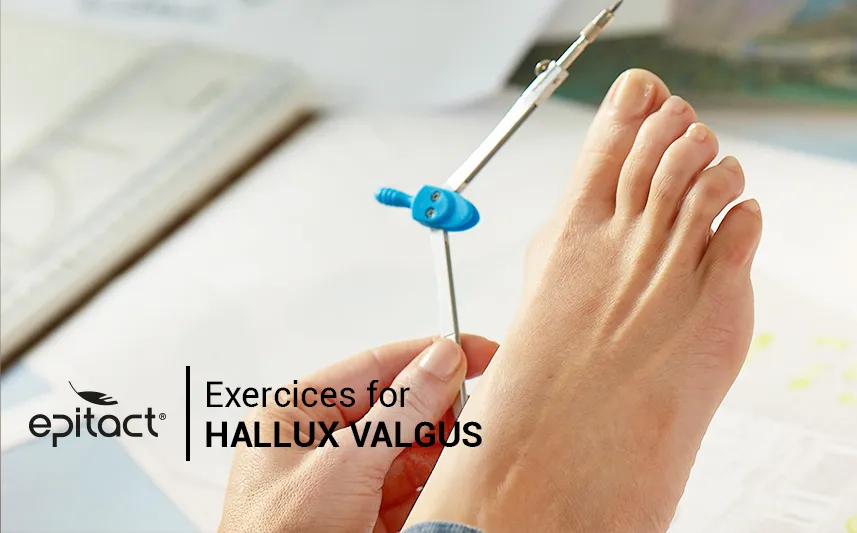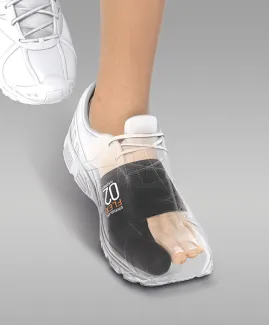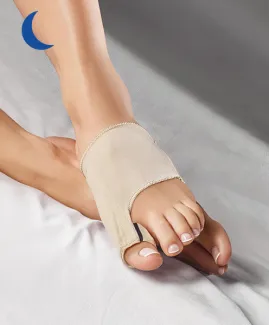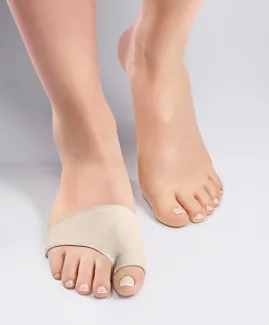
You are starting to have hallux valgus and you’d like to limit its worsening? By doing some easy 'hallux valgus exercises' regularly, you can extend the joint flexibility to delay the evolution of the condition.
Move the hallux to keep the joint mobility
Keeping the mobility of the great toe affected by the hallux valgus is essential to avoid worsening its complications. To do that, the joint has to be stimulated. This exercise has to be done sat on the ground, back against a wall. Bring your leg towards you, toes upward. Grab your big toe and gently pull it up, as if you wanted to remove it from the feet. Then bring it back down. Try to bring the toe to its ideal axis with these movements. Do twenty back-and-forth up and down.
Limit the pronation which contributes to the evolution of the hallux valgus
Among the factors contributing to the appearance of a bunion, there is often the pronation (i.e. the feet tend to move inward) that leads to fallen arches. To limit this effect, there is a very simple exercise to do as often as possible when you’re at home: you have to walk on the external side of your feet avoiding your great toe to touch the ground. By walking this way, the squeezing of the foot arch and the expansion of the forefoot are limited.
Another major factor in the appearance of a bunion is a lack of muscular balance between the abductor and adductor muscles of the hallux(1). In particular, it has been demonstrated that a morphological change of the abductor muscle of the hallux happens when there is a hallux valgus(2). This could happen in the very early stage of the deformity.
So, in order to strengthen this muscle, there is a pretty simple exercise: the short-foot exercise (fig. 1). Foot flat on the ground, lift the internal arch of the foot by trying to bring the first metatarsal head toward the heel without contracting the calf muscle or bending the toes. It’s the most efficient exercise to strengthen the hallux abductor.
Fig. 1. The "short-foot exercise" for hallux valgus
Strengthen the forefoot with simple and effective exercises
To hold together the forefoot and maintain its tone, the muscles of this area must be strengthen by some simple exercises(3). This will slow down the worsening of the hallux valgus symptoms.
-
Second exercise: the toes-spread-out exercise (fig. 2). It consists to spread all of your toes and then to try put down the first and the fifth while keeping the other three in the air. This is not an easy exercise but it improves the coordination while strengthen your muscles.
Fig. 2 "The toe-spread-out exercise" for hallux-valgus
-
Third exercise: the first-toe extension (fig. 3). This exercise consists in lifting your big toe and to keep the others on the floor.
Fig. 3 "The first-toe-extension exercise" for hallux valgus
-
Fourth exercise: the second to fifth toe extension (fig. 4). It’s the opposite of the previous exercise. In this case, you have to lift toes number 2,3,4 and 5 while letting the hallux (big toe) on the floor.
Fig. 4 "The second-to-fifth-toe-extension exercise" for hallux valgus
-
Lastly, to relax: place a tennis ball under your foot and move it from forefoot to heel. Under the forefoot, you can move it from inside to outside to stimulate the whole of the foot. To do as often as possible.
These exercises, simple to do, will strengthen your foot. If pain appear after these exercises, ask your physiotherapist or your podiatrist for advice. However, hallux valgus is a deformity that cannot disappear over time.
In addition, if your hallux valgus still moves literally, do not hesitate to wear a bunion fixer*. It’s effective while walking by acting on factors which may aggravate the deformity. It can be worn in all closed footwear. And if you want a night correction, we recommend you the rigid bunion corrector for night use*.
*These products are class I medical devices that bear the CE marking under this regulation. Carefully the instructions before use. Manufacturer: Millet Innovation. 04/2020
For more details about this general and simplified approach, here are further sources:
(1)Arinci İncel N, Genç H, Erdem HR, Yorgancioglu ZR. Muscle Imbalance in Hallux Valgus: An Electromyographic Study. American Journal of Physical Medicine & Rehabilitation. mai 2003;82(5):345‑9.
(2)Stewart S, Ellis R, Heath M, Rome K. Ultrasonic evaluation of the abductor hallucis muscle in hallux valgus : a cross-sectional observational study. BMC Musculoskelet Disord. déc 2013;14(1):45.
(3)Gooding TM, Feger MA, Hart JM, Hertel J. Intrinsic Foot Muscle Activation During Specific Exercises: A T2 Time Magnetic Resonance Imaging Study. Journal of Athletic Training. août 2016;51(8):644‑50.
 Pharmacie
Pharmacie


